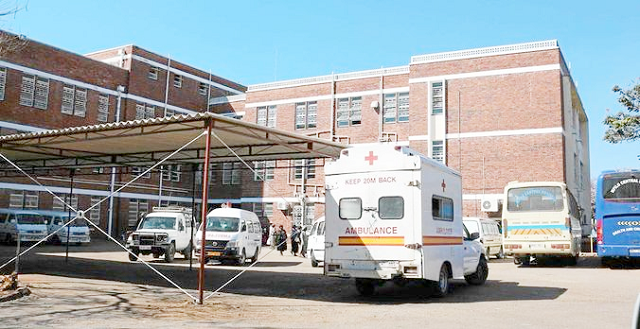
The Sunday News

Pathisa Nyathi
ARMY lorries droned, whined, coughed and crackled slowly down the gentle slope festooned with red- roofed government offices. They were expertly and skilfully manoeuvred with maximum care as if they transported delicate and fragile cargo.
They snaked their way down past the Native Commissioner’s offices in a northerly direction. Their destination was somewhere between Mzilikazi Village, built in 1945, and Barbourfields, an elite township for Africans named after Bulawayo Mayor H R Barbour. The two townships were part of the four which back then were referred to as the Bulawayo African Townships (BAT). The other two townships were Makokoba, and Nguboyenja.
The army trucks were heading to a new health facility that had just opened. The year is 1958. African patients are being transferred from the Bulawayo Memorial Hospital between 10th and 11th Avenues in Bulawayo.
The Bulawayo Memorial Hospital had been established as far back as 1894 when the foundation stone was laid, following Conquest the previous year. It was Bulawayo’s oldest medical facility catering for Europeans, Coloureds, Asians and Africans.
Built through public prescription at a cost of 6 500-00, Bulawayo Memorial Hospital was initially manned by the Dominican sisters coming from the nearby Dominican Convent. Only in 1925 was the health facility taken over by government. In Bulawayo there was a clinic for Africans established by the Native Welfare Society for Matabeleland in Makokoba Township close to the Beer Garden. In the early days, uptake of health services was low all round.
Expecting mothers preferred to deliver their babies at home. Later, government added beds to the maternity ward, being the second of two wards at the clinic. The Municipality built Confinement Centres provided with electric lighting where maternity cases were admitted for six days.
The lorries were transferring African patients to Mpilo Central Hospital for what were then referred to as Natives. Red brick structures constituted what was Bulawayo’s largest medical facility for Africans. Pioneering African patients were being taken to the newly established medical wards. Meanwhile, the European patients had, in 1943, been transferred to the new Bulawayo Government Hospital in Kumalo. That marked the beginning of what was to become the United Bulawayo Hospitals (UBH).
Africans had, however, remained behind at the Bulawayo Memorial Hospital where there had been racially segregated facilities. Europeans occupied the eastern section of the hospital while Africans were housed in the western end with both Coloureds and Asians being assigned to the middle sections. Now an exclusively African health facility was ready to receive the Africans.
As far back as 1948 plans were afoot to establish a native hospital. Plans were drawn and municipal land was transferred to government in order to increase the government’s entitlement to the Commonage. Work duly started and in August 1950 Impilo Native Maternity Hospital was commissioned.
The new hospital was manned by both black and white nurses with the former having been trained at the McCord Zulu Hospital run by the American Board Mission just outside Durban. Polyana Mnkandla (later becoming Mahlangu after marriage to Peter Sivalo Mahlangu) was one such McCord-trained nurse who joined Impilo Native Maternity Hospital in 1950. African nurses also trained at the Baragwanath Hospital in Johannesburg, one Mayobe the famous Highlanders Football Club fanatic.
It is 60 years this year since Mpilo Central Hospital was established as a general hospital although, as pointed out above, the maternity wing was already in operation before 1958. Mpilo Central Hospital authorities have seized the opportunity to celebrate the hospital’s Golden Jubilee. September the 28th has been set aside for the celebrations, partly as a way of documenting progress so far achieved since the late 1950s to date.
A commemorative book is being compiled which, pictorially, captures Mpilo Central Hospital as it stands today. A photo shoot session has been undertaken with that in mind. It is envisaged the book will be available by the time of the commemorations. There are also plans to invite some identified veteran nurses and other staff for a get together during which they will go down memory lane as they reminisce over their years at Mpilo Central Hospital during their youthful days.
A new maternity wing was opened at Mpilo Central Hospital and named after Queen Loziba KaPhahlana Thebe who was King Mzilikazi KaMatshobana’s senior Queen at Emhlangeni, Inyathi till her death in 1861. Apparently, the name has not quite stuck. During our photo shoot that became apparent and we advised that a plaque be made indicating the name of the maternity wing so that, hopefully, the name may be popularised. Just about Sister Ndebele alone in the Maternity Ward knew that the wing had been named after Queen Loziba Thebe alongside the restaurant at the Rainbow Hotel.
Phenomenal infrastructural development was enhanced during the days of the Federation of Rhodesia and Nyasaland which came into existence in 1953. In addition to Mpilo Central Hospital, Harari Central Hospital (later popularised as Gomo) in Salisbury (now Harare) was also constructed. The University College of Rhodesia and Nyasaland (now the University of Zimbabwe, UZ) was built, so was Lake Kariba.
We wish Mpilo Central Hospital a happy Golden Jubilee characterised by professional health delivery!



